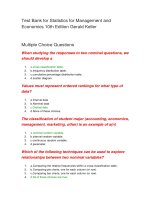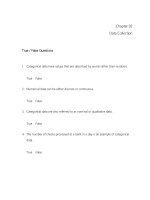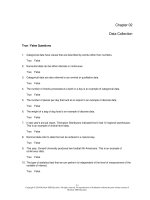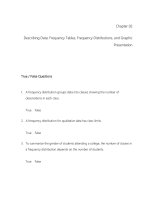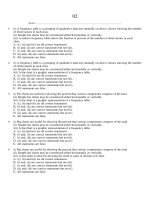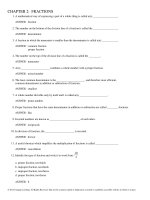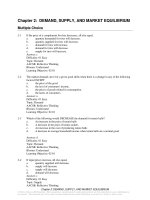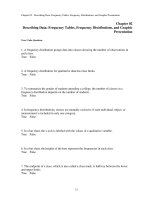Statistics for business and economics 12th edition anderson test bank
Bạn đang xem bản rút gọn của tài liệu. Xem và tải ngay bản đầy đủ của tài liệu tại đây (329.45 KB, 25 trang )
CHAPTER 2—DESCRIPTIVE STATISTICS: TABULAR AND GRAPHICAL
DISPLAYS
MULTIPLE CHOICE
1. A frequency distribution is a tabular summary of data showing the
a. fraction of items in several classes
b. percentage of items in several classes
c. relative percentage of items in several classes
d. number of items in several classes
ANS: D
PTS: 1
TOP: Descriptive Statistics
2. A frequency distribution is
a. a tabular summary of a set of data showing the relative frequency
b. a graphical form of representing data
c. a tabular summary of a set of data showing the frequency of items in each of several
nonoverlapping classes
d. a graphical device for presenting categorical data
ANS: C
PTS: 1
TOP: Descriptive Statistics
3. A tabular summary of a set of data showing the fraction of the total number of items in several classes
is a
a. frequency distribution
b. relative frequency distribution
c. frequency
d. cumulative frequency distribution
ANS: B
PTS: 1
TOP: Descriptive Statistics
4. The relative frequency of a class is computed by
a. dividing the midpoint of the class by the sample size
b. dividing the frequency of the class by the midpoint
c. dividing the sample size by the frequency of the class
d. dividing the frequency of the class by the sample size
ANS: D
PTS: 1
TOP: Descriptive Statistics
5. The percent frequency of a class is computed by
a. multiplying the relative frequency by 10
b. dividing the relative frequency by 100
c. multiplying the relative frequency by 100
d. adding 100 to the relative frequency
ANS: C
PTS: 1
TOP: Descriptive Statistics
6. The sum of frequencies for all classes will always equal
a. 1
b. the number of elements in a data set
c. the number of classes
d. a value between 0 and 1
ANS: B
PTS: 1
TOP: Descriptive Statistics
7. Fifteen percent of the students in a school of Business Administration are majoring in Economics, 20%
in Finance, 35% in Management, and 30% in Accounting. The graphical device(s) which can be used
to present these data is (are)
a. a line chart
b. only a bar chart
c. only a pie chart
d. both a bar chart and a pie chart
ANS: D
PTS: 1
TOP: Descriptive Statistics
8. A researcher is gathering data from four geographical areas designated: South = 1; North = 2; East = 3;
West = 4. The designated geographical regions represent
a. categorical data
b. quantitative data
c. label data
d. either quantitative or categorical data
ANS: A
PTS: 1
TOP: Descriptive Statistics
9. Categorical data can be graphically represented by using a(n)
a. histogram
b. frequency polygon
c. ogive
d. bar chart
ANS: D
PTS: 1
TOP: Descriptive Statistics
10. A cumulative relative frequency distribution shows
a. the proportion of data items with values less than or equal to the upper limit of each class
b. the proportion of data items with values less than or equal to the lower limit of each class
c. the percentage of data items with values less than or equal to the upper limit of each class
d. the percentage of data items with values less than or equal to the lower limit of each class
ANS: A
PTS: 1
TOP: Descriptive Statistics
11. If several frequency distributions are constructed from the same data set, the distribution with the
widest class width will have the
a. fewest classes
b. most classes
c. same number of classes as the other distributions since all are constructed from the same
data
ANS: A
PTS: 1
TOP: Descriptive Statistics
12. The sum of the relative frequencies for all classes will always equal
a. the sample size
b. the number of classes
c. one
d. any value larger than one
ANS: C
PTS: 1
TOP: Descriptive Statistics
13. The sum of the percent frequencies for all classes will always equal
a. one
b. the number of classes
c. the number of items in the study
d. 100
ANS: D
PTS: 1
TOP: Descriptive Statistics
14. The most common graphical presentation of quantitative data is a
a. histogram
b. bar chart
c. relative frequency
d. pie chart
ANS: A
PTS: 1
TOP: Descriptive Statistics
15. The total number of data items with a value less than the upper limit for the class is given by the
a. frequency distribution
b. relative frequency distribution
c. cumulative frequency distribution
d. cumulative relative frequency distribution
ANS: C
PTS: 1
TOP: Descriptive Statistics
16. The relative frequency of a class is computed by
a. dividing the cumulative frequency of the class by n
b. dividing n by cumulative frequency of the class
c. dividing the frequency of the class by n
d. dividing the frequency of the class by the number of classes
ANS: C
PTS: 1
TOP: Descriptive Statistics
17. In constructing a frequency distribution, the approximate class width is computed as
a. (largest data value - smallest data value)/number of classes
b. (largest data value - smallest data value)/sample size
c. (smallest data value - largest data value)/sample size
d. largest data value/number of classes
ANS: A
PTS: 1
TOP: Descriptive Statistics
18. In constructing a frequency distribution, as the number of classes are decreased, the class width
a. decreases
b. remains unchanged
c. increases
d. can increase or decrease depending on the data values
ANS: C
PTS: 1
TOP: Descriptive Statistics
19. The difference between the lower class limits of adjacent classes provides the
a. number of classes
b. class limits
c. class midpoint
d. class width
ANS: D
PTS: 1
TOP: Descriptive Statistics
20. In a cumulative frequency distribution, the last class will always have a cumulative frequency equal to
a. one
b. 100%
c. the total number of elements in the data set
d. None of these alternatives is correct.
ANS: C
PTS: 1
TOP: Descriptive Statistics
21. In a cumulative relative frequency distribution, the last class will have a cumulative relative frequency
equal to
a. one
b. zero
c. the total number of elements in the data set
d. None of these alternatives is correct.
ANS: A
PTS: 1
TOP: Descriptive Statistics
22. In a cumulative percent frequency distribution, the last class will have a cumulative percent frequency
equal to
a. one
b. 100
c. the total number of elements in the data set
d. None of these alternatives is correct.
ANS: B
PTS: 1
TOP: Descriptive Statistics
23. Data that provide labels or names for categories of like items are known as
a. categorical data
b. quantitative data
c. label data
d. category data
ANS: A
PTS: 1
TOP: Descriptive Statistics
24. A tabular method that can be used to summarize the data on two variables simultaneously is called
a. simultaneous equations
b. crosstabulation
c. a histogram
d. an ogive
ANS: B
PTS: 1
TOP: Descriptive Statistics
25. A graphical presentation of the relationship between two variables is
a. an ogive
b. a histogram
c. either an ogive or a histogram, depending on the type of data
d. a scatter diagram
ANS: D
PTS: 1
TOP: Descriptive Statistics
26. A histogram is said to be skewed to the left if it has a
a. longer tail to the right
b. shorter tail to the right
c. shorter tail to the left
d. longer tail to the left
ANS: D
PTS: 1
TOP: Descriptive Statistics
27. When a histogram has a longer tail to the right, it is said to be
a.
b.
c.
d.
symmetrical
skewed to the left
skewed to the right
none of these alternatives is correct
ANS: C
PTS: 1
TOP: Descriptive Statistics
28. In a scatter diagram, a line that provides an approximation of the relationship between the variables is
known as
a. approximation line
b. trend line
c. line of zero intercept
d. line of zero slope
ANS: B
PTS: 1
TOP: Descriptive Statistics
29. A histogram is
a. a graphical presentation of a frequency or relative frequency distribution
b. a graphical method of presenting a cumulative frequency or a cumulative relative
frequency distribution
c. the history of data elements
d. the same as a pie chart
ANS: A
PTS: 1
TOP: Descriptive Statistics
30. A situation in which conclusions based upon aggregated crosstabulation are different from
unaggregated crosstabulation is known as
a. wrong crosstabulation
b. Simpson's rule
c. Simpson's paradox
d. aggregated crosstabulation
ANS: C
PTS: 1
TOP: Descriptive Statistics
31. Which of the following is a graphical summary of a set of data in which each data value is represented
by a dot above the axis?
a. histogram
b. box plot
c. dot plot
d. crosstabulation
ANS: C
PTS: 1
TOP: Descriptive Statistics
32. An Ogive is constructed by plotting a point corresponding to the ___ frequency of each class.
a. relative
b. cumulative
c. percent
d. octave
ANS: B
PTS: 1
TOP: Descriptive Statistics
33. The ___ can be used to show the rank order and shape of a data set simultaneously.
a. ogive
b. pie chart
c. stem-and-leaf display
d. bar chart
ANS: C
PTS: 1
TOP: Descriptive Statistics
34. Which of the following graphical methods shows the relationship between two variables?
a. pie chart
b. ogive
c. crosstabulation
d. dot plot
ANS: C
PTS: 1
TOP: Descriptive Statistics
35. The reversal of conclusions based on aggregate and unaggregated data is called:
a. Simpson’s paradox
b. Trim’s paradox
c. Poisson dilemma
d. Simon’s paradox
ANS: A
PTS: 1
TOP: Descriptive Statistics
Exhibit 2-1
A sample of 15 children shows their favorite restaurants:
McDonalds
Luppi's
Mellow Mushroom
Friday's
McDonalds
McDonalds
Pizza Hut
Taco Bell
McDonalds
Mellow Mushroom
Luppi's
Pizza Hut
McDonalds
Friday's
McDonalds
36. Refer to Exhibit 2-1. Which of the following is the correct frequency distribution?
a. McDonalds 4, Friday’s 3, Pizza Hut 1, Mellow Mushroom 4, Luppi’s 3, Taco Bell 1
b. McDonalds 6, Friday’s 2, Pizza Hut 2, Mellow Mushroom 2, Luppi’s 2, Taco Bell 1
c. McDonalds 6, Friday’s 1, Pizza Hut 3, Mellow Mushroom 1, Luppi’s 2, Taco Bell 2
d. None of these alternatives is correct.
ANS: B
PTS: 1
TOP: Descriptive Statistics
37. Refer to Exhibit 2-1. Which of the following is the correct relative frequency for McDonalds?
a. 0. 27
b. 0.5
c. 0.4
d. 6
ANS: C
PTS: 1
TOP: Descriptive Statistics
38. Refer to Exhibit 2-1. Which of the following is the correct percent frequency for McDonalds?
a. 10%
b. 27%
c. 2%
d. 40%
ANS: D
PTS: 1
TOP: Descriptive Statistics
Exhibit 2-2
The numbers of hours worked (per week) by 400 statistics students are shown below.
Number of hours
0- 9
Frequency
20
10 - 19
20 - 29
30 - 39
80
200
100
39. Refer to Exhibit 2-2. The class width for this distribution
a. is 9
b. is 10
c. is 39, which is: the largest value minus the smallest value or 39 - 0 = 39
d. varies from class to class
ANS: B
PTS: 1
TOP: Descriptive Statistics
40. Refer to Exhibit 2-2. The number of students working 19 hours or less
a. is 80
b. is 100
c. is 180
d. is 300
ANS: B
PTS: 1
TOP: Descriptive Statistics
41. Refer to Exhibit 2-2. The relative frequency of students working 9 hours or less
a. is 20
b. is 100
c. is 0.95
d. 0.05
ANS: D
PTS: 1
TOP: Descriptive Statistics
42. Refer to Exhibit 2-2. The percentage of students working 19 hours or less is
a. 20%
b. 25%
c. 75%
d. 80%
ANS: B
PTS: 1
TOP: Descriptive Statistics
43. Refer to Exhibit 2-2. The cumulative relative frequency for the class of 20 - 29
a. is 300
b. is 0.25
c. is 0.75
d. is 0.5
ANS: C
PTS: 1
TOP: Descriptive Statistics
44. Refer to Exhibit 2-2. The cumulative percent frequency for the class of 30 - 39 is
a. 100%
b. 75%
c. 50%
d. 25%
ANS: A
PTS: 1
TOP: Descriptive Statistics
45. Refer to Exhibit 2-2. The cumulative frequency for the class of 20 - 29
a. is 200
b. is 300
c. is 0.75
d. is 0.5
ANS: B
PTS: 1
TOP: Descriptive Statistics
46. Refer to Exhibit 2-2. If a cumulative frequency distribution is developed for the above data, the last
class will have a cumulative frequency of
a. 100
b. 1
c. 30 - 39
d. 400
ANS: D
PTS: 1
TOP: Descriptive Statistics
47. Refer to Exhibit 2-2. The percentage of students who work at least 10 hours per week is
a. 50%
b. 5%
c. 95%
d. 100%
ANS: C
PTS: 1
TOP: Descriptive Statistics
48. Refer to Exhibit 2-2. The number of students who work 19 hours or less is
a. 80
b. 100
c. 200
d. 400
ANS: B
PTS: 1
TOP: Descriptive Statistics
49. Refer to Exhibit 2-2. The midpoint of the last class is
a. 50
b. 34
c. 35
d. 34.5
ANS: D
PTS: 1
TOP: Descriptive Statistics
Exhibit 2-3
A survey of 800 college seniors resulted in the following crosstabulation regarding their undergraduate
major and whether or not they plan to go to graduate school.
Undergraduate Major
Business
Engineering
70
84
182
208
252
292
Graduate School
Yes
No
Total
Others
126
130
256
Total
280
520
800
50. Refer to Exhibit 2-3. What percentage of the students does not plan to go to graduate school?
a. 280
b. 520
c. 65
d. 32
ANS: C
PTS: 1
TOP: Descriptive Statistics
51. Refer to Exhibit 2-3. What percentage of the students' undergraduate major is engineering?
a.
b.
c.
d.
292
520
65
36.5
ANS: D
PTS: 1
TOP: Descriptive Statistics
52. Refer to Exhibit 2-3. Of those students who are majoring in business, what percentage plans to go to
graduate school?
a. 27.78
b. 8.75
c. 70
d. 72.22
ANS: A
PTS: 1
TOP: Descriptive Statistics
53. Refer to Exhibit 2-3. Among the students who plan to go to graduate school, what percentage indicated
"Other" majors?
a. 15.75
b. 45
c. 54
d. 35
ANS: B
PTS: 1
TOP: Descriptive Statistics
Exhibit 2-4
Michael's Compute-All, a national computer retailer, has kept a record of the number of laptop
computers they have sold for a period of 80 days. Their sales records are shown below:
Number of Laptops Sold
Number of Days
0 - 19
20 - 39
40 - 59
60 - 79
80 - 99
5
15
30
20
10
Total
80
54. Refer to Exhibit 2-4. The class width of the above distribution is
a. 0 to 100
b. 20
c. 80
d. 5
ANS: B
PTS: 1
TOP: Descriptive Statistics
55. Refer to Exhibit 2-4. The lower limit of the first class is
a. 5
b. 80
c. 0
d. 20
ANS: C
PTS: 1
TOP: Descriptive Statistics
56. Refer to Exhibit 2-4. If one develops a cumulative frequency distribution for the above data, the last
class will have a frequency of
a. 10
b. 100
c. 0 to 100
d. 80
ANS: D
PTS: 1
TOP: Descriptive Statistics
57. Refer to Exhibit 2-4. The percentage of days in which the company sold at least 40 laptops is
a. 37.5%
b. 62.5%
c. 90.0%
d. 75.0%
ANS: D
PTS: 1
TOP: Descriptive Statistics
58. Refer to Exhibit 2-4. The number of days in which the company sold less than 60 laptops is
a. 20
b. 30
c. 50
d. 60
ANS: C
PTS: 1
TOP: Descriptive Statistics
PROBLEM
1. Thirty students in the School of Business were asked what their majors were. The following represents
their responses (M = Management; A = Accounting; E = Economics; O = Others).
A
E
M
a.
b.
M
E
A
M
M
O
A
A
A
M
O
M
M
E
E
E
M
E
M
A
M
Construct a frequency distribution and a bar chart.
Construct a relative frequency distribution and a pie chart.
ANS:
(a)
Major
M
A
E
O
Total
Frequency
12
9
6
3
30
(b)
Relative
Frequency
0.4
0.3
0.2
0.1
1.0
O
M
A
A
A
M
PTS: 1
TOP: Descriptive Statistics
2. Twenty employees of the Ahmadi Corporation were asked if they liked or disliked the new district
manager. Below you are given their responses. Let L represent liked and D represent disliked.
L
D
D
D
a.
b.
L
D
L
D
D
L
D
L
L
L
D
D
D
D
L
L
Construct a frequency distribution and a bar chart.
Construct a relative frequency distribution and a pie chart.
ANS:
a and b
Preferences
L
D
Total
Frequency
9
11
20
Relative
Frequency
0.45
0.55
1.00
PTS: 1
TOP: Descriptive Statistics
3. Forty shoppers were asked if they preferred the weight of a can of soup to be 6 ounces, 8 ounces, or 10
ounces. Below you are given their responses.
6
10
8
6
a.
b.
6
10
8
8
6
8
8
8
10
8
10
8
8
6
8
10
8
6
8
10
8
6
6
8
10
8
10
10
6
6
8
8
6
6
6
6
Construct a frequency distribution and graphically represent the frequency distribution.
Construct a relative frequency distribution and graphically represent the relative frequency
distribution.
ANS:
a and b
Preferences
6 ounces
8 ounces
10 ounces
Total
Frequency
14
17
9
40
Relative
Frequency
0.350
0.425
0.225
1.000
PTS: 1
TOP: Descriptive Statistics
4. A student has completed 20 courses in the School of Arts and Sciences. Her grades in the 20 courses
are shown below.
A
C
B
C
a.
b.
B
C
A
B
A
B
B
C
B
B
B
B
C
B
B
A
Develop a frequency distribution and a bar chart for her grades.
Develop a relative frequency distribution for her grades and construct a pie chart.
ANS:
a and b
Grade
A
B
C
Total
Frequency
4
11
5
20
Relative
Frequency
0.20
0.55
0.25
1.00
PTS: 1
TOP: Descriptive Statistics
5. A sample of 50 TV viewers were asked, "Should TV sponsors pull their sponsorship from programs
that draw numerous viewer complaints?" Below are the results of the survey. (Y = Yes; N = No; W =
Without Opinion)
N
N
Y
W
N
a.
b.
W
Y
N
W
Y
N
N
Y
N
N
N
N
W
W
Y
Y
N
N
Y
N
N
N
Y
W
W
N
N
W
N
Y
N
Y
W
W
Y
Construct a frequency distribution and a bar chart.
Construct a relative frequency distribution and a pie chart.
ANS:
a and b
No
Yes
Without Opinion
Total
Frequency
24
15
11
50
Relative
Frequency
0.48
0.30
0.22
1.00
Y
N
N
Y
N
N
N
Y
W
Y
PTS: 1
TOP: Descriptive Statistics
6. The following data shows the price of PAO, Inc. stock over the last 8 months.
Month
1
2
3
4
5
6
7
8
a.
b.
Price
2.08
2.00
2.03
1.91
1.88
1.87
1.70
1.67
Develop a scatter diagram and draw a trend line through the points.
What kind of relationship exists between stock price and time (negative, positive, or no
relation)?
ANS:
a.
b. Negative
PTS: 1
TOP: Descriptive Statistics
7. Below you are given the examination scores of 20 students.
52
63
92
90
a.
b.
c.
d.
99
72
58
75
92
76
65
74
86
95
79
56
84
88
80
99
Construct a frequency distribution for this data. Let the first class be 50 - 59.
Construct a cumulative frequency distribution.
Construct a relative frequency distribution.
Construct a cumulative relative frequency distribution.
ANS:
a.
Score
50 - 59
60 - 69
70 - 79
80 - 89
90 - 99
Total
PTS: 1
Frequency
3
2
5
4
6
20
b.
c.
Cumulative
Frequency
3
5
10
14
20
Relative
Frequency
0.15
0.10
0.25
0.20
0.30
1.00
d.
Cumulative
Relative
Frequency
0.15
0.25
0.50
0.70
1.00
TOP: Descriptive Statistics
8. The frequency distribution below was constructed from data collected from a group of 25 students.
Height
(in Inches)
Frequency
58 - 63
64 - 69
70 - 75
76 - 81
82 - 87
88 - 93
94 - 99
a.
b.
c.
3
5
2
6
4
3
2
Construct a relative frequency distribution.
Construct a cumulative frequency distribution.
Construct a cumulative relative frequency distribution.
ANS:
Height
(In Inches)
58 - 63
64 - 69
70 - 75
76 - 81
82 - 87
88 - 93
94 - 99
PTS: 1
Frequency
3
5
2
6
4
3
2
a.
b.
Relative
Frequency
0.12
0.20
0.08
0.24
0.16
0.12
0.08
1.00
Cumulative
Frequency
3
8
10
16
20
23
25
c.
Cumulative
Relative
Frequency
0.12
0.32
0.40
0.64
0.80
0.92
1.00
TOP: Descriptive Statistics
9. The frequency distribution below was constructed from data collected on the quarts of soft drinks
consumed per week by 20 students.
Quarts of
Soft Drink
0- 3
4- 7
8 - 11
12 - 15
16 - 19
a.
b.
c.
Frequency
4
5
6
3
2
Construct a relative frequency distribution.
Construct a cumulative frequency distribution.
Construct a cumulative relative frequency distribution.
ANS:
Quarts of
Soft Drinks
0- 4
4- 8
8 - 12
Frequency
4
5
6
a.
b.
Relative
Frequency
0.20
0.25
0.30
Cumulative
Frequency
4
9
15
c.
Cumulative
Relative
Frequency
0.20
0.45
0.75
12 - 16
16 - 20
Total
3
2
20
PTS: 1
0.15
0.10
1.00
18
20
0.90
1.00
TOP: Descriptive Statistics
10. The grades of 10 students on their first management test are shown below.
94
68
a.
b.
c.
61
75
96
85
66
84
92
78
Construct a frequency distribution. Let the first class be 60 - 69.
Construct a cumulative frequency distribution.
Construct a relative frequency distribution.
ANS:
a.
Class
60 - 69
70 - 79
80 - 89
90 - 99
Total
PTS: 1
Frequency
3
2
2
3
10
b.
Cumulative
Frequency
3
5
7
10
c.
Relative
Frequency
0.3
0.2
0.2
0.3
1.0
TOP: Descriptive Statistics
11. There are 800 students in the School of Business Administration. There are four majors in the School:
Accounting, Finance, Management, and Marketing. The following shows the number of students in
each major.
Major
Accounting
Finance
Management
Marketing
Number of Students
240
160
320
80
Develop a percent frequency distribution and construct a bar chart and a pie chart.
ANS:
Major
Accounting
Finance
Management
Marketing
Percent Frequency
30%
20%
40%
10%
PTS: 1
TOP: Descriptive Statistics
12. You are given the following data on the ages of employees at a company. Construct a stem-and-leaf
display.
26
52
41
42
32
44
53
44
28
36
55
40
45
42
48
36
58
27
32
37
7
2
1
3
8
6
2
5
6
2
8
7
4
ANS:
2|6
3|2
4|0
5|2
PTS: 1
4
5
8
TOP: Descriptive Statistics
13. Construct a stem-and-leaf display for the following data.
12
49
ANS:
52
43
51
45
37
19
47
36
40
32
38
44
26
48
57
22
31
18
1|2
2|2
3|1
4|0
5|1
8
6
2
3
2
9
6
4
7
PTS: 1
7
5
8
7
8
9
TOP: Descriptive Statistics
14. The ACT scores of a sample of business school students and their genders are shown below.
Gender
Female
Male
Total
a.
b.
c.
d.
e.
Less than 20
24
40
64
ACT Scores
20 up to 25
168
96
264
25 and more
48
24
72
Total
240
160
400
How many students scored less than 20?
How many students were female?
Of the male students, how many scored 25 or more?
Compute row percentages and comment on any relationship that may exist between ACT
scores and gender of the individuals.
Compute column percentages.
ANS:
a.
b.
c.
64
240
24
d.
Gender
Female
Male
Less than 20
10%
25%
ACT Scores
20 up to 25
70%
60%
25 and more
20%
15%
Total
100%
100%
From the above percentages it can be noted that the largest percentages of both genders'
ACT scores are in the 20 to 25 range. However, 70% of females and only 60% of males
have ACT scores in this range. Also it can be noted that 10% of females' ACT scores are
under 20, whereas, 25% of males' ACT scores fall in this category.
e.
Gender
Female
Male
Total
PTS: 1
SAT Scores
Less than 20
20 up to 25
37.5%
63.6%
62.5%
36.4%
100%
100%
25 and more
66.7%
33.3%
100%
TOP: Descriptive Statistics
15. For the following observations, plot a scatter diagram and indicate what kind of relationship (if any)
exist between x and y.
x
2
y
7
6
3
5
4
19
9
17
11
ANS:
A positive relationship between x and y appears to exist.
PTS: 1
TOP: Descriptive Statistics
16. For the following observations, plot a scatter diagram and indicate what kind of relationship (if any)
exist between x and y.
x
8
5
3
2
1
y
4
5
9
12
14
ANS:
A negative relationship between x and y appears to exist.
PTS: 1
TOP: Descriptive Statistics
17. Five hundred recent graduates indicated their majors as follows.
Major
Frequency
Accounting
Finance
Economics
Management
Marketing
Engineering
Computer Science
Total
a.
b.
60
100
40
120
80
60
40
500
Construct a relative frequency distribution.
Construct a percent frequency distribution.
ANS:
Major
Frequency
a.
Relative
Frequency
b.
Percent
Frequency
60
100
40
120
80
60
40
500
0.12
0.20
0.08
0.24
0.16
0.12
0.08
1.00
12
20
8
24
16
12
8
100
Accounting
Finance
Economics
Management
Marketing
Engineering
Computer Science
Total
PTS: 1
TOP: Descriptive Statistics
18. A sample of the ages of 10 employees of a company is shown below.
20
30
30
20
40
30
30
20
50
40
Construct a dot plot for the above data.
ANS:
10
PTS: 1
•
•
•
20
•
•
•
•
30
•
•
40
•
50
60
TOP: Descriptive Statistics
19. The following data set shows the number of hours of sick leave that some of the employees of
Bastien's, Inc. have taken during the first quarter of the year (rounded to the nearest hour).
19
23
36
12
59
a.
b.
c.
d.
22
47
25
20
39
27
11
34
28
48
24
55
16
29
32
28
25
45
21
40
12
42
49
10
31
Develop a frequency distribution for the above data. (Let the width of your classes be 10
units and start your first class as 10 - 19.)
Develop a relative frequency distribution and a percent frequency distribution for the data.
Develop a cumulative frequency distribution.
How many employees have taken less than 40 hours of sick leave?
ANS:
a.
Hours of
Sick Leave Taken
10 - 19
20 - 29
30 - 39
40 - 49
50 - 59
d. 22
PTS: 1
b.
Relative
Freq.
0.20
0.37
0.16
0.20
0.07
Freq.
6
11
5
6
2
b.
Percent
Freq.
20
37
16
20
7
c.
Cum.
Freq.
6
17
22
28
30
TOP: Descriptive Statistics
20. The sales records of a real estate company for the month of May shows the following house prices
(rounded to the nearest $1,000). Values are in thousands of dollars.
105
30
a.
b.
c.
55
60
45
75
85
79
75
95
Develop a frequency distribution and a percent frequency distribution for the house prices.
(Use 5 classes and have your first class be 20 - 39.)
Develop a cumulative frequency and a cumulative percent frequency distribution for the
above data.
What percentage of the houses sold at a price below $80,000?
ANS:
Sales Price
(In Thousands of Dollars)
20 - 39
40 - 59
60 - 79
80 - 99
100 - 119
c.
70%
PTS: 1
a.
a.
b.
Freq.
1
2
4
2
1
Percent
Freq.
10
20
40
20
10
Cum.
Freq.
1
3
7
9
10
TOP: Descriptive Statistics
b.
Cum.
Percent
Freq.
10
30
70
90
100
21. The test scores of 14 individuals on their first statistics examination are shown below.
95
75
87
63
52
92
43
81
77
83
84
91
78
88
Construct a stem-and-leaf display for these data.
ANS:
4
5
6
7
8
9
3
2
3
5
1
1
PTS: 1
7
3
2
8
4
5
7
8
TOP: Descriptive Statistics
22. A survey of 400 college seniors resulted in the following crosstabulation regarding their undergraduate
major and whether or not they plan to go to graduate school.
Graduate School
Yes
No
Total
a.
b.
c.
d.
Undergraduate Major
Business
Engineering
35
42
91
104
126
146
Others
63
65
128
Total
140
260
400
Are a majority of the seniors in the survey planning to attend graduate school?
Which discipline constitutes the majority of the individuals in the survey?
Compute row percentages and comment on the relationship between the students'
undergraduate major and their intention of attending graduate school.
Compute the column percentages and comment on the relationship between the students'
intention of going to graduate school and their undergraduate major.
ANS:
a. No, majority (260) will not attend graduate school
b. Majority (146) are engineering majors
c.
Undergraduate Major
Graduate School
Business
Engineering
Yes
25%
30%
No
35%
40%
Others
45%
25%
Total
100%
100%
Majority who plan to go to graduate school are from "Other" majors. Majority of those who will
not go to graduate school are engineering majors.
d.
Graduate School
Yes
No
Total
Undergraduate Major
Business
Engineering
27.8%
28.8%
72.2%
71.2%
100%
100%
Others
49.2%
50.8%
100%
Approximately the same percentages of Business and engineering majors plan to attend graduate
school (27.8% and 28.8% respectively). Of the "Other" majors approximately half (49.2%) plan
to go to graduate school.
PTS: 1
TOP: Descriptive Statistics

